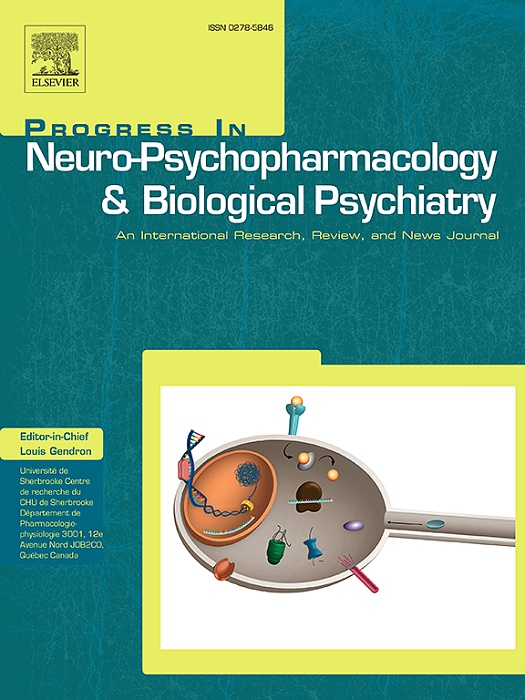Prenatal ethanol exposure impairs hippocampal plasticity and cognition in adolescent mice
IF 5.3
2区 医学
Q1 CLINICAL NEUROLOGY
Progress in Neuro-Psychopharmacology & Biological Psychiatry
Pub Date : 2024-10-22
DOI:10.1016/j.pnpbp.2024.111174
引用次数: 0
Abstract
Background
Prenatal alcohol exposure (PAE) induces a wide range of neurodevelopmental disabilities that are grouped under the term ‘fetal alcohol spectrum disorders’ (FASD). The effects of PAE on brain development are dependent on complex neurochemical events, including modification of AMPA receptors (AMPARs). We have recently found that chronic ethanol (EtOH) exposure decreases AMPA-mediated neurotransmission and expression through the overexpression of the specific microRNA (miR)137 and 501-3p, which target GluA1 AMPA subunit, in the developing hippocampus in vitro. Here, we explored how PAE mice may alter AMPAergic synapses in the hippocampus, and its effects on behavior.
Methods
To model PAE, we exposed C57Bl/6 pregnant mice to 10 % EtOH during during the first 10 days of gestation (GD 0–10; equivalent to the first trimester of pregnancy in humans). AMPA subunits postsynaptic expression in the hippocampus, electrical properties of CA1 neurons, memory recognition, and locomotor functions were then analyzed in adolescent PAE-exposed offspring.
Results
PAE adolescent mice showed dysregulation of AMPAergic neurotransmission, and increased miR 501-3p expression, associated with a significant reduction of spontaneous AMPA currents and intrinsic somatic excitability. In addition, PAE reduced the phosphorylation of AMPAR-containing GluA1 subunit, despite an increase in its total levels. Of note, the total levels of GluA2 and GluA3 AMPA receptors were enhanced as well. Consistently, at behavioral level, PAE reduced object recognition without altering locomotor activity.
Conclusions
Our study shows that PAE leads to dysfunctional formation of AMPAergic synapses that could be responsible for neurobehavioral impairments, contributing to the understanding of the pathogenesis of FASD.
产前接触乙醇会损害青春期小鼠的海马可塑性和认知能力
背景:产前酒精暴露(PAE)会诱发多种神经发育障碍,这些障碍被归类为 "胎儿酒精谱系障碍"(FASD)。PAE 对大脑发育的影响取决于复杂的神经化学事件,包括 AMPA 受体(AMPARs)的改变。我们最近发现,慢性乙醇(EtOH)暴露会通过在体外发育的海马中过表达靶向 GluA1 AMPA 亚基的特异性 microRNA(miR)137 和 501-3p,从而降低 AMPA 介导的神经传递和表达。在此,我们探讨了 PAE 小鼠如何改变海马中的 AMPA 能突触及其对行为的影响:为了建立 PAE 模型,我们在 C57Bl/6 怀孕小鼠妊娠期的前 10 天(GD 0-10;相当于人类妊娠期的前三个月)将其暴露于 10% 的 EtOH 中。然后分析了暴露于 PAE 的青春期后代海马中 AMPA 亚基突触后表达、CA1 神经元的电特性、记忆识别和运动功能:结果:PAE 暴露的青少年小鼠表现出 AMPA 能神经传递失调,miR 501-3p 表达增加,与自发 AMPA 电流和内在体细胞兴奋性显著降低有关。此外,PAE 还减少了含 AMPAR 的 GluA1 亚基的磷酸化,尽管其总水平有所增加。值得注意的是,GluA2 和 GluA3 AMPA 受体的总水平也有所提高。同样,在行为水平上,PAE会降低物体识别能力,但不会改变运动活动:我们的研究表明,PAE 导致 AMPA 能突触形成障碍,这可能是神经行为障碍的原因,有助于了解 FASD 的发病机制。
本文章由计算机程序翻译,如有差异,请以英文原文为准。
求助全文
约1分钟内获得全文
求助全文
来源期刊
CiteScore
12.00
自引率
1.80%
发文量
153
审稿时长
56 days
期刊介绍:
Progress in Neuro-Psychopharmacology & Biological Psychiatry is an international and multidisciplinary journal which aims to ensure the rapid publication of authoritative reviews and research papers dealing with experimental and clinical aspects of neuro-psychopharmacology and biological psychiatry. Issues of the journal are regularly devoted wholly in or in part to a topical subject.
Progress in Neuro-Psychopharmacology & Biological Psychiatry does not publish work on the actions of biological extracts unless the pharmacological active molecular substrate and/or specific receptor binding properties of the extract compounds are elucidated.

 求助内容:
求助内容: 应助结果提醒方式:
应助结果提醒方式:


